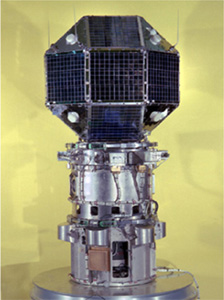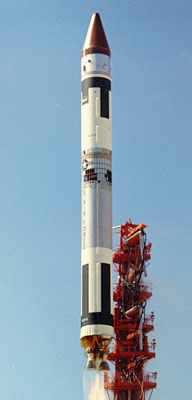LES-1 (Lincoln Experimental Satellite)
 Mission
Mission
LES 1 and 2 (Lincoln Experimental Satellite 1 and 2) were essentially identical experimental communication satellites. Both featured a single X-band transponder and an 8-horn electronically switched antenna. Additionally, attitude control and sensing experiments were conducted.
The initial program objective was to build, launch, and field a system to demonstrate practical military satellite communications. The availability of Project West Ford’s advanced superhigh-frequency (SHF) technology (at seven to eight gigahertz) contributed to the decision to design the system for that band. The Department of Defense’s concurrent procurement of a series of SHF satellites and terminals, commencing with the Initial Defense Communications Satellite Program (IDCSP), meant that lessons learned from the experiments would find an additional application.
 LES-1, launched from Cape Canaveral on 11 February 1965, accomplished only a few of its objectives. Apparently because of mis wiring of the ordnance circuitry, the satellite never left circular orbit and ceased transmitting in 1967. LES-2, the twin of LES-1 fared much better; it achieved its planned final orbit on 6 May 1965.
LES-1, launched from Cape Canaveral on 11 February 1965, accomplished only a few of its objectives. Apparently because of mis wiring of the ordnance circuitry, the satellite never left circular orbit and ceased transmitting in 1967. LES-2, the twin of LES-1 fared much better; it achieved its planned final orbit on 6 May 1965.
An Amateur Radio Astronomer in North Cornwall accidentally picked up the signal and after cross checking with various lists, has identified it as LES-1 built by the Massachusetts Institute of Technology and launched in 1965. The satellite failed to reach its intended orbit owing to a wiring error and has been drifting out of control ever since.
Phil Williams G3YPQ from near Bude noticed its peculiar signal drift caused by its tumbling end over end every 4 seconds as the solar panels become shadowed by the engine. ‘This gives the signal a particularly ghostly sound as the voltage from the solar panels fluctuates’ Phil says.
It is likely that the on board batteries have now disintegrated and some other component failure has caused the transmitter on 237Mhz, to start up when its in sunlight.
LES-1 is about the size of a small car, It is not likely to re-enter the atmosphere for a long time as the orbit is still relatively high. It poses no threat other than that caused by the thousands of other pieces of space junk in orbit.
Phil says its remarkable to think that electronics built nearly 50 years ago, 12 years before Voyager 1, and long before microprocessors and integrated circuits, is still capable of working in the hostile environs of space.
Listening to the signal you can easily imagine the craft tumbling over and over every 4 seconds and the transmitter starting up as the sun rises. He refers to the hobby as ‘Radio-Archeology’!
Satellite LES-1 received in Brazil by PY2ZX. RX is a bit lower than 237 MHz.
Two Line Element Set (TLE):
LES1 01002U 65008C 13056.23244782 .00000008 00000-0 00000+0 0 5206 01002 032.1476 037.8304 0014269 347.9988 092.3634 09.88347627735661
Homepage and other references:
